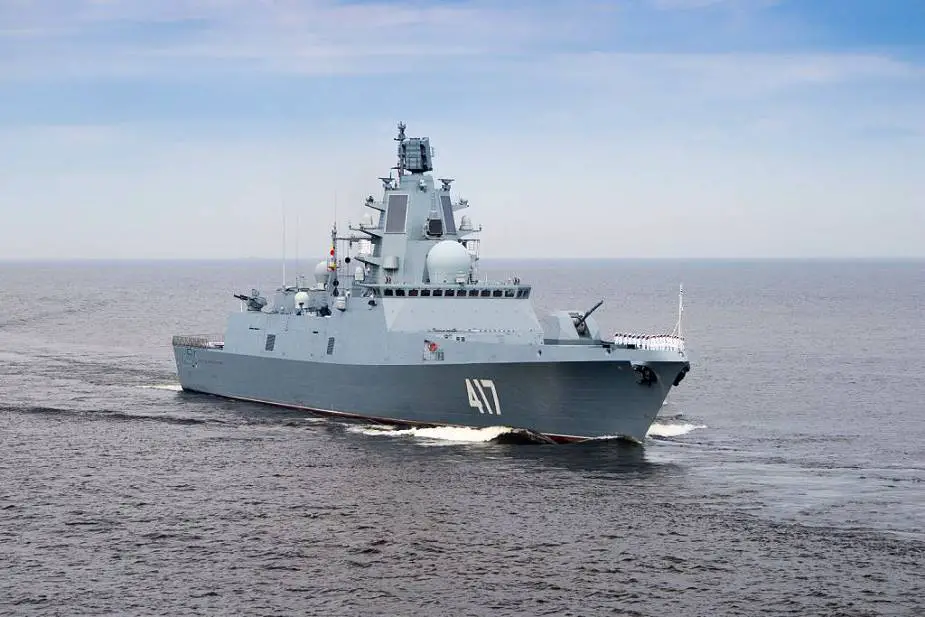According to information published by the Russian press agency TASS on December 30, 2020, the Russian Navy has successfully completed trials of hypersonic Tsirkon missile shadowed the completion of acceptance tests of the anti-submarine Otvet missile complex. Technical documentation is being finalized for the complex to be officially accepted into service by the Russian Navy.
Follow Navy Recognition on Google News at this link
 Russian navy Admiral Kasatonov frigate of project 22350 successfully completed acceptance trials of the Otvet missile complex. (Picture source Russian Exercises Twitter)
Russian navy Admiral Kasatonov frigate of project 22350 successfully completed acceptance trials of the Otvet missile complex. (Picture source Russian Exercises Twitter)
The complex detects, classifies and destroys submarines or unmanned underwater craft at major distances. The latest Vodopad RPK-6M antisubmarine complex was created yet in Soviet time and accepted into service in 1981. Vodopad has an unusual trajectory. The guided antisubmarine missile sails underwater as an ordinary torpedo for some time after the launch. The solid-fuel jet engine then starts up to deliver the missile to a distance of 50 km. The warhead comprising a depth bomb or 400mm small electric torpedo UMGT-1 is then released on a parachute.
In 1990s, Soviet designers decided to exclude the underwater stage of a new antisubmarine missile after the launch. 91RE2 missile was designed for export of Club complex (export Kalibr option) and fired from a vertical universal launcher. The presence of various missiles helped change munitions depending on the missions and the situation.
A new antisubmarine missile complex became necessary, as the speed and maneuverability of nuclear and non-nuclear submarines increased and stealth characteristics improved. Otvet was designed.
Its test production began in 2019. In November 2020, the Admiral Kasatonov frigate of project 22350 successfully completed acceptance trials of the complex. Otvet includes onboard sonar, a submersible helicopter sonar, 3S-14 vertical launcher, antisubmarine missile with 324mm MPT-1UM torpedoes, communication and launch preparation systems. Underwater targets can be detected by both sonars, as well as other warships and submarines, Il-38 and Tu-142 antisubmarine aircraft.
The data input and trajectory calculation take only ten seconds. The missile is launched by a ballistic trajectory to the target area. The two-stage solid-fuel missile is 7.65 meters long and the launch weight exceeds two tons. It has an inertial guidance system. Upon the separation of the first stage, the second stage takes the missile by a guided trajectory to the submarine area. The trajectory is adjusted, and the onboard inertial system guides the missile to the assigned point by aerodynamic fins.
Upon the separation of the second stage, MPT-1UM torpedo splashed on a parachute, submerges and automatically searches for the target. It moves by a spiral without starting up the engine, but with operating acoustic homing warhead. The engine starts up after the target is detected. The torpedo approaches and destroys the submarine.
The 324mm MPT-1UM torpedo weighs 300 kg. It is 3 meters long and the warhead weighs 60 kg. The maximum depth is 800 meters and the maximum speed is 50 knots. The range of the multichannel warhead with spatial and time correlation of signals and adaptive angle of advance is two thousand meters.
Otvet mission time is 1-2 minutes. The distance ranges from 5 to 50 km. The maximum flight speed is Mach 2.5. Four missiles can simultaneously attack one submarine. The kill probability is 0.91 in case of guidance mean square error of 300-500 meters.
Otvet will increase antisubmarine capabilities of the Russian Navy. Major surface forces can build up multilayered antisubmarine defense. In the close zone, Paket-NM antisubmarine complex fights submarines and torpedoes. Otvet is in charge of the distance of 5 — 50 km. Torpedoes and depth bombs of Ka-27PL helicopters operate in a 100-km range.
Otvet will be installed on project 22350 frigates, upgraded antisubmarine ships of project 1155M, project 20385 corvettes, the overhauled Admiral Nakhimov heavy nuclear cruiser of project 11442M.
© Copyright 2020 TASS Navy Recognition. All rights reserved. This material may not be published, broadcast, rewritten or redistributed.



